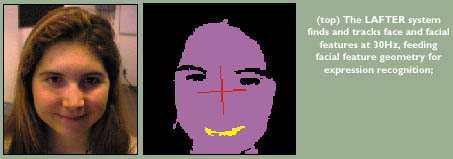Research from MIT (3)
(Pentland, 2000)
'Smart Rooms' technology
Where people are:
2D tracking of user difficult (occlusion of data)
System augmented with a dynamic & constraint-based skeletal model
Sample rate of just 30Hz
Typical noise: 9mm for translation, 0.6 degrees for rotation
Pentland (2000)
Who people are:
Many face recognition systems highly reliable
Audio now employed to increase accuracyFacial expression recognition:
Many useful applications: recognizing driver or student sleepiness
Lips an important part of facial expression
Head and lips are tracked
Hidden Markov Models used to statistically determine shape
Pentland (2000)
